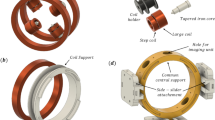Abstract
Collaborative robotics and additive manufacturing are two enabling technologies of the Industry 4.0 manufacturing paradigm. Their synergic integration requires novel and effective design approaches, aiming to the development of new reconfigurable solutions for customised processes and products. This work presents an integrated approach that exploits the capabilities of Cobots to mimic the repetitive and exhausting operator’s movements as well as the competitive advantages offered by additive manufacturing to realize tailored equipment. In particular, the case study shows the development of a customised device for the manipulation of biomedical components by means of a Cobot, which is introduced in a workstation to replace manual operations. Moreover, the flexibility and the effectiveness of a Cobot can be improved thanks to customised devices for gripping and pick-and-place operations based on a specific application. During the development phase, we simulated the assembly process, and tested different options. The final configuration, with conformal circuits and suction cups, can pick, manipulate and assembly the biomedical components, and thanks to a Fused Filament Fabrication technology is additively manufactured. In conclusion, this developed prototypal solution proves the real capabilities offered by integrating Cobots and additive manufacturing for the lean automation of a biomedical workstation.







Similar content being viewed by others
References
Vysocky, A.L., Novak, P.E.: Human–robot collaboration in industry. MM Sci. J. 9(2), 903–906 (2016)
Villani, V., Pini, F., Leali, F., Secchi, C., Fantuzzi, C.: Survey on human–robot interaction for robot programming in industrial applications. IFAC PapersOnLine 51(11), 66–71 (2018)
Magrini, E., Ferraguti, F., Ronga, A.J., Pini, F., De Luca, A., Leali, F.: Human–robot coexistence and interaction in open industrial cells. Robot. Comput. Integr. Manuf. 61, 101846 (2020)
MacDougall, W.: Industrie 4.0: Smart Manufacturing for the Future. Future Markets. Germany Trade & Invest, Berlin (2014)
Rüßmann, M., Lorenz, M., Gerbert, P., Waldner, M.: Industry 40: The Future of Productivity and Growth in Manufacturing Industries. Boston Consulting Group, Boston (2015)
Dalpadulo E., Pini F., Leali F.: Assessment of design for additive manufacturing based on CAD platforms. In: International Conference on Design Tools and Methods in Industrial Engineering, ADM, pp. 970–981 (2019)
Gherardini, F., Mascia, M.T., Bettelli, V., Leali, F.: A co-design method for the additive manufacturing of customised assistive devices for hand pathologies. J. Integr. Des. Process Sci. 22(1), 21–37 (2018). https://doi.org/10.3233/jid-2018-0002
Frandsen, C.S., Nielsen, M.M., Chaudhuri, A., Jayaram, J., Govindan, K.: In search for classification and selection of spare parts suitable for additive manufacturing: a literature review. Int. J. Prod. Res. 58(4), 970–996 (2020)
Durão, L.F.C.S., Christ, A., Zancul, E., Anderl, R., Schützer, K.: Additive manufacturing scenarios for distributed production of spare parts. Int. J. Adv. Manuf. Technol. 93(1–4), 869–880 (2017)
Bak, D.: Rapid prototyping or rapid production? 3D printing processes move industry towards the latter. Assem Autom 23(4), 340–345 (2003). https://doi.org/10.1108/01445150310501190
Pini F., Leali F., Ansaloni M.: A systematic approach to the engineering design of a HRC workcell for bio-medical product assembly. In: IEEE 20th Conference on Emerging Technologies and Factory Automation (ETFA), Luxembourg, pp. 1–8 (2015)
Pini F., Ansaloni M., Leali F.: Evaluation of operator relief for an effective design of HRC workcells. In: IEEE 21st International Conference on Emerging Technologies and Factory Automation (ETFA), Berlin, pp. 1–6 (2016)
Acknowledgements
The authors would like to acknowledge Giuliana Gavioli and Enrico Corazzari from B.Braun Avitum Italy S.p.A. for their support.
Author information
Authors and Affiliations
Corresponding author
Additional information
Publisher's Note
Springer Nature remains neutral with regard to jurisdictional claims in published maps and institutional affiliations.
Rights and permissions
About this article
Cite this article
Rossi, F., Pini, F., Carlesimo, A. et al. Effective integration of Cobots and additive manufacturing for reconfigurable assembly solutions of biomedical products. Int J Interact Des Manuf 14, 1085–1089 (2020). https://doi.org/10.1007/s12008-020-00682-9
Received:
Accepted:
Published:
Issue Date:
DOI: https://doi.org/10.1007/s12008-020-00682-9




